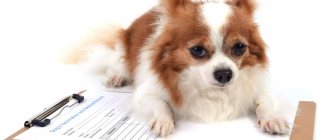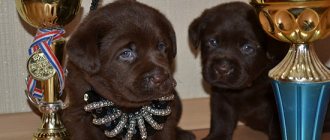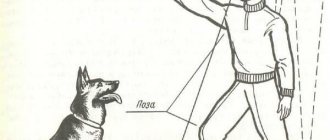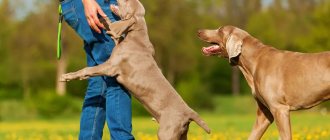Why does a dog need a brand?
They brand mainly purebred animals registered with the Russian Cynological Federation (abbreviated as RKF) or with any other alternative organization of cynologists. This is done for the correct identification of dogs in breeding work. First of all, so that at exhibitions the owners are not accused of the fact that the dog entered for participation has nothing to do with the pedigree presented to the members of the commission.
In recent years, mongrel dogs have also begun to be branded, so that in the event of a loss, people who found a runaway pet would not ask the question: “How to find the dog’s owner?” A brand is a tattoo, usually containing a special code that can be used to find the nursery where the animal was born and the owner's contact phone number. A mark can be applied by copying the number of another purebred animal, or simply dishonest sellers who want to use this sign to convince buyers of the purebred nature of the puppy. In this case, unfortunately, the branding of dogs will not make it easier to find the owners.
Dog branding procedure
How are puppies branded? This procedure includes the following steps:
- The skin is prepared for branding: the hair is shaved, and an antiseptic is applied to the skin.
- Despite the fact that the procedure is practically painless, it is better to secure the dog’s body and paws so that the pet does not escape.
- If necessary, apply anesthetic gel.
- The next step depends on the chosen tool for applying the brand. Before using the tattoo machine, a stencil of the future code is first applied.
- A tattoo is applied using this stencil. At the end of the handle there is a needle with which punctures are made. The device itself has a reservoir with paint, which goes under the skin at the moment it is punctured.
Bones for dogs: can puppies be given and which ones?
The branding procedure takes no more than 5 minutes.
If tongs are used, the stamp is applied in one motion. After which a coloring pigment is applied, which penetrates the skin at the puncture sites. This method is used only for ear branding.
Important! Despite the fact that this procedure is practically painless for puppies, it is necessary to securely secure the pet to avoid injury and defects in the branding.
Applying a brand
How to “read” the mark?
In order to find out how to find a dog’s owner using a brand, you must first read it.
Usually the mark is located in places inaccessible to licking: inside the ear, on the stomach, under the armpit. Purebred dogs are taught to show their mark from early childhood, so finding one is not too difficult.
If the dog’s mark has been washed away and cannot be clearly defined, then experienced dog breeders recommend completely shaving the hair on this area of the dog’s body and wiping the mark with either alcohol or vegetable oil. After this, the signs will become clearer. The dog’s ear, if there is a mark inside, can be “illuminated” with a flashlight from the outside.
How to obtain an export pedigree
An export pedigree is issued if the owner of the dog is not a citizen of the Russian Federation. It is necessary in order to register the dog with the Kennel Club of the country where the pet’s owner lives.
To get it you need:
- go to the nearest RKF kennel club;
- pay a target contribution to the club;
- provide the club with the top part of the puppy card, say that an export pedigree is required, and sign a consent to the processing of personal data;
- come at the appointed time for the finished export pedigree (please note that there must be an inscription Export Pedigree in the upper right corner).
If you live in another state and want to issue an export pedigree for a dog purchased in Russia, you can contact one of the RKF federations at the address: [email protected] , attaching to the letter a copy of the puppy’s birth certificate received from the breeder. Our employees will check whether the litter is registered and send you the details for transferring the target contribution.
NB! To register an export pedigree, the dog must have a chip.
Finding a dog's owner in club stud books
Once all the numbers and letters have been identified, it is worth figuring out which of them may be useful. Depending on the order in which the letters and numbers are, as well as how many there are, you can determine in which kennel the dog was born (provided that it is purebred), and contact the breeder and ask for information about the owners. Most often, conscientious nursery owners store this data.
First, it’s worth understanding what brands different cynological federations have, then it will become clear how to find a dog’s owner by brand:
- The mark consists of 3 Latin letters and numbers (their number varies from 1 to 6 characters). Such a mark was most likely given by a breeder or a club - a member of the RKF, and the data is stored in their database. The letters indicate the name of the kennel where the dog was born. By contacting the Federation with a written request (or by email), you can find out the name and contact details of the nursery.
- How else to find the owner of a dog using the RKF mark? The brands of this organization did not always look the same. If the mark consists of 3 Russian letters and any number of numbers, then this means that it was also put by members of the RKF, but only until 2005. If the dog is elderly, then it is likely that data about it can also be found in the Federation database.
- The brand code begins with the letter E, followed by one or two numbers, then any Latin letter and again three or five numbers. A combination of two letters and numbers, these are the marks that are given by the Union of Cynological Organizations of Russia (abbreviated as SKOR). The numbers after the letter E indicate the year the dog was born. The following are serial numbers in ascending order. All information about clubs can be found by writing a letter to SKOR.
- The dog's brand number begins with the letters KW (Kind World), followed by numbers and letters in random order. The mark was put by the International Association of Cynologists “Kind World” (abbreviated as IAC “Kind World”). The brand codes of all association clubs are available for independent search on the official website of the Federation.
It is worth remembering that when sending a written request to any cynological organization, you must indicate the full stamp number, the estimated breed of the dog, color, approximate age and, if possible, attach a photo of your four-legged friend.
The Federation will not send the applicant the address of the alleged owner, but the contact information of the nursery where the dog was born. The breeder usually always keeps the contact information of the dog's owners. Experienced dog breeders claim that a good breeder treats his puppies like children and, most likely, will offer to take care of the foundling and further search for the owner.
What is the procedure
Next, we will talk in more detail about the branding procedure itself, the rules for using tools and what the marks look like. It is important to remember that before applying the mark, it is necessary to carry out a number of preparatory procedures.
- Removing hair from the area where the mark will be located. It should be noted that according to the rules of the RKF, the mark can only be located on two areas of the skin: in the groin or on the dog’s ear.
- Skin disinfection is very important to protect your puppy from various inflammations.
- Applying a stencil to the selected area. Most often, a regular helium pen is used for this. Then comes the marking process itself, during which a number of tools are used.
- After branding, the area should not be wetted for a week.
Devices used
During the branding process, a number of tools are used, such as: special ink, a branding tong or a branding pen.
- A pen kleimator is a special tool that looks like a regular pen with a needle at the end. It works on the principle of a regular machine that is used to tattoo people. When pressed, the rod pierces the skin and releases a small amount of dye. The device is easy to find in specialized stores.
- Claimator tongs are a device that resembles flat tongs, in the blades of which there is a compartment for typing a code. Each symbol here is made in the form of a separate plate on which several needles are applied. Typically this tool is used to brand the ear. After the punctures are made, the area is covered with a special tattoo paste. After some time it falls off, leaving a black mark. This device is easy to find in specialized stores. Using forceps works faster and more painlessly than using a pen.
- The most common tattoo ink used is the same as for people, but always black.
In general, the entire procedure for branding one puppy takes from 2 to 5 minutes. Next, we will discuss existing tagging rules in more detail.
Rules
First of all, it is important to know that dog branding is carried out in the interval from 45 days to 2 months of the life of a puppy of any purebred litter. According to the RKF rules, it is prohibited to brand adult dogs. The mark is applied by a veterinarian or the owner of the nursery himself. Before the procedure begins, each puppy in the litter is examined, litter inspection reports are drawn up, in which data and codes for the puppies are entered. In addition, the code of each mark must be registered in the RKF.
After making the marks, marks are placed in the club’s general litter card. The data is also entered into the puppy’s metrics and breeding documents. It must be remembered that over time the tattoo begins to fade and becomes fuzzy. In order to update the trail, you need to contact your nursery. Next we will talk in more detail about the meaning of brands.
Finding a dog owner through databases
If you don’t have time to wait for a response from the Federation, you can try to find the dog’s brand in the animal database on the Internet, but there is no single database of the RKF or any other dog breeding federation on the Internet. Various Internet pages are filled with amateur dog handlers, often the owners themselves, who leave the details of their pet so that if it goes missing, it will be easier to find it.
There are many databases, this article describes only a few:
- The database of nursery brands on the Infodog website is quite complete, reliable, and equipped with a convenient search. In this database, as a criterion, you can select both the brand and the city or breed in which certain nurseries specialize.
- A constantly updated database on the website of the Zoo Club encyclopedia, numbering more than three thousand brands. In addition to addresses and telephone numbers, it contains not only the stamp numbers that the kennel puts now, but also shows the marks that were put on dogs before 2005.
- The international database Pedigree Dogsfiles is a database of RKF brands that does not have a search tool, but checking a dog’s brand will not be difficult, because the letters of the brand are arranged alphabetically.
- Claws Charity Lost and Found Dogs and Cats File. A resource that helps you find missing dogs and cats, or their owners, animals found on the street. The data comes from ordinary people. It would be a good idea to check the information on this website, maybe they are looking for the dog, or it has already been lost, and volunteers will be able to tell you about its fate.
- The website of the Dachshund land dachshund breeding kennel is a complete database of old and new brands of RKF kennels, you can even try to look for a kennel that is no longer functioning, but perhaps the address and telephone number still belong to the breeder.
- The national electronic identification database combines data on animals not only in Russia, but throughout Europe. In addition to the brand, you can find the owner of the dog if you know the number of the microchip implanted in him. The database contains data about the animals themselves and their owners.
Training so your dog doesn't get lost
You can reduce the risk of losing your pet if you train your dog properly. To do this, it is necessary to take into account the characteristics of the environment and the nature of the animal.
First of all, your pet must learn such simple commands as “Come to me” and “Stop, stay.” He must master them so well that he can carry them out unquestioningly under any circumstances. Then you don’t have to worry that your pet will be run over by a car, or he will scare those around him, or he will run away in an unknown direction. You should not try to catch up with the dog , shouting after him “I’ll kill you!” Come to me immediately! You should act completely differently - start running away from him, and it is best if you conduct training in a safe place.
Search through databases of breed sites and forums
Is it possible to find a dog's owner using a brand in other ways? People often leave their data not in general, hard-to-reach databases, but on breed forum threads and in special sections of websites about animals. If the breed of the found dog is known, it is worth trying to look for contacts of the owner or kennel on the following resources:
- Catalog of representatives of the German Shepherd breed Gsdog is a database of pedigree German Shepherds of the FCI system, whose representative in Russia is RKF.
- The forum for collie and sheltie lovers contains on its pages data from kennels that breed Scottish Sheepdog (collie) dogs. Contact information may be out of date (information was last updated in 2013).
- Russian Retriever Club. There is a sheet with the “prefixes” of labrador retriever kennels. Data on common Labradors may also be available from kennels registered on this site. It is difficult to search - the first letters of the marks are not sorted alphabetically.
- Database of dogs of hunting breeds Huntdogs, a database of brands of dogs of hunting breeds constantly updated by animal owners. All information is divided into breed branches, so if the breed is difficult to identify, the search will become more difficult.
Zootechnical document
The pet's initial breeding registration data is entered into the stud book, and from there information about the pet is entered into the state stud book. Specific specialists (dog handlers, livestock specialists, accountants and other professionals) are responsible for processing and systematizing data using computer technology and German breed standards.
Important! For a knowledgeable person, such a book is an excellent source of valuable information about the shepherd. The most interesting in this regard were the famous pedigrees of the RKNO. The main pages of the papers usually reflect how many specific puppies were born and died before activation, what nicknames the owners gave them (enter in the original language), colors, and inbreeding is fully described.
On the subsequent spreads (2nd and 3rd pages) the four tribes of the dog's relatives are clearly shown with detailed numbers of their pedigrees, exact information and results of training and confirmation of selection. Data on the closest ancestors (first and second generation) is provided additionally and includes a detailed description of the pets selected, coat color and basic information about littermates. At the end there is a designated area for stamping a hip dysplasia screening stamp.
Important! Filling out the correct description during selection is an extremely informative line in the pedigree. This allows dog owners to read about the pros and cons of the dog’s parents and the puppy’s relatives, and to trace their relationship with each other.
As for dogs brought from other countries, but still owned by Russian citizens - despite the presence of confirmation of the primary breeding abroad, these pets must still be registered with the Verkhovna Rada of the Russian Federation. They are tested in accordance with the standard regulations and upon successful passing of the necessary tests, they also receive a corresponding document for a period of 2 years.
All information, reflected as fully as possible in the pedigree, allows a person, with the help of one document, to form a preliminary idea about the dog he is interested in. Therefore, it is important to know in advance about all the advantages of this paper: it will not only allow you to select a puppy according to breed standards, but also confirm the origin of your German Shepherd. The main thing in this matter is to correctly collect and officially document all the necessary information about your pet’s ancestors, so that they will have legal force in the future.
Return to content
What to do if the nursery is known?
Once it has become known in which kennel the dog could have been born (it may happen that there will be several kennels with the same information), you need to call or come to the owner of the kennel and tell him when and under what circumstances the dog was found, show a photo, tell him, where the mark is located. According to experienced dog breeders, most breeders do not even need to know the brand number to understand that the dog was born in his kennel, you just need to see it in the photo.
Chip or brand: pros and cons
If you still have to choose between a chip or a stamp, you should take into account:
- chipping will not replace the presence of a brand, since the chip is not an indicator of the breed - it can even be installed on a yard Jack;
- the tattoo may become difficult to read over time, in this sense the chip is more reliable;
- The chip is definitely worth choosing if you plan to travel abroad;
- A microchip can be placed on an adult dog;
- the cost of chipping is much higher than the cost of applying a brand;
- branding is a more common and accessible procedure;
- the microchip contains more information;
- the code is visible to the naked eye, unlike a chip, which requires special equipment;
- A microchip cannot be faked, unlike a brand.
In any case, the choice has to be made by the owner of the kennel or the owner of the dog. You can identify a lost pet if you have a chip and a stamp.
How to find a dog's owner by brand if there is no data on the Internet
The main thing you should never forget: if a dog has a mark, it is unlikely that it was simply abandoned to the mercy of fate; there will definitely be those who are familiar with the dog or its owners.
First of all, you need to independently post information about the animal in special groups on social networks that specialize in searching for missing animals in various cities of Russia. Breed forums will also come to the rescue, “breeders” often unite in clubs, surely someone will recognize the dog, there will be “littermates” (brothers and sisters of the foundling), and the fate of the dog will no longer be so vague.
Now, the dog’s brand number cannot be published in full; it must be provided by the owners themselves. It is enough to indicate only the first letters, allowing you to understand in which nursery the animal was born. Otherwise, simple swindlers who want to appropriate someone else's property may call. By the way, it is also better not to leave your address or phone number in the public domain; it is better to limit yourself to an email address.
How to obtain a RKF pedigree for a puppy with the metric of an alternative canine organization
If your dog has a puppy certificate from an alternative cynological organization (not RKF), then in order to obtain a RKF pedigree, you must first register a pedigree with the canine organization that issued the puppy certificate. Then:
- with the received pedigree, come to the nearest RKF kennel club, where the owner will be asked for consent to the processing of personal data, pedigree and consent to a truncated version of the RKF pedigree (in case the origin of the dog cannot be established);
- pay a target contribution to the club;
- come to the club for your pedigree at the appointed time.
What to do if the owners are found, but they don’t want the dog
Unfortunately, this often happens: the old owners are found, but they don’t want to return the dog. Then the person who found the dog should find out all the necessary information: the dog’s age, preferred diet, and also be sure to ask for a veterinary passport with vaccinations and the dog’s documents (puppy card or pedigree). If the would-be owners confirm their refusal in writing, that will be ideal. After this, you can look for the dog a new home where he will be loved.
How to get a pedigree
In order to receive an extract from the RKF VERK (full pedigree of the RKF), you need the puppy's metric (puppy card) RKF, which is the first important document in the life of a puppy, confirming its breed.
If you have a metric, the process of obtaining a complete pedigree of the RKF is very simple and consists of the following steps:
- you need to go to the nearest RKF kennel club. A complete list of authorized clubs can be found on the RKF.Online platform ;
- pay a target contribution to the club;
- provide the club with the top part of the puppy card, sign consent to the processing of personal data;
- come to the club at the appointed time for a complete RKF pedigree.
NB! Registration of pedigrees is carried out through clubs included in the RKF system (you can choose any one that is convenient for you). Pedigree registration for individuals is not carried out directly at the RKF office.
Helpful information
The main thing is not to forget that it is imperative to look for the owners of a dog with a brand. You need to search for at least a month; people may be away and not immediately discover the loss. Experienced dog breeders warn that if you simply “appropriate” a found dog, then in the future this may serve as a reason for being accused of theft of personal property, because the owners of a purebred dog have a contract, photographs and witnesses. Such cases have arisen in practice more than once, so everyone needs to know how to find the owner of a dog by brand number.
The procedure for registering the pedigree of the Russian Cynological Federation
Project Description
An extract from the All-Russian Unified Pedigree Book of the RKF (VERK RKF) or the complete pedigree of the RKF is a document confirming that the dog is purebred and that it is registered with the VERK.
The extract from the Verk RKF (full pedigree of the RKF) contains data on at least three generations of the ancestors of the registered dogs, indicating their nicknames, abbreviations of stud books and entry numbers in stud books, brand codes and/or microchips, colors, available titles, results of tests passed , as well as various tests and studies.
A full RKF pedigree is required to obtain admission to mating, participation in official competitions, competitions and exhibitions. In addition, the full pedigree of the RKF will help facilitate the search if the dog is lost, since dogs that have received the full pedigree of the RKF must have a brand tattoo. It will be easier for the person who finds the pet to find the owner by reading the stamp, which contains information about the dog.
How to fill out a puppy's metric correctly
Before sending a puppy card in order to make a pedigree for the dog, it must be filled out correctly. It's not at all difficult to do this. But there are several important points that you need to pay attention to when filling out:
- Fill out the metric legibly, in block letters. If any letter is illegible, it may be incorrectly entered into the pedigree. This will lead to the fact that the pedigree will have to be drawn up again.
- You only need to fill in two fields correctly: owner and address. – In the “owner” column, enter your last name and initials. – In the “address” column we write the registration address indicated in your passport. You must include your postal code. Without an index, your puppy metrics will not be accepted for exchange.
How much does a dog's pedigree cost?
How much does it cost to do a pedigree for a dog without taking into account the fee that the kennel club may charge you? You can find out the latest information on the RKF website.
Here is the estimated cost of the pedigree (the price is as of 2015):
- The cost of a regular exchange (15 days): for citizens of the Russian Federation - 1000 rubles, and for foreign citizens - 2750 rubles.
- The cost of urgent exchange (1 day): for citizens of the Russian Federation - 2000 rubles, and for foreign citizens - 3750 rubles.










